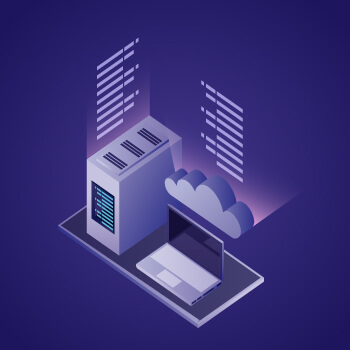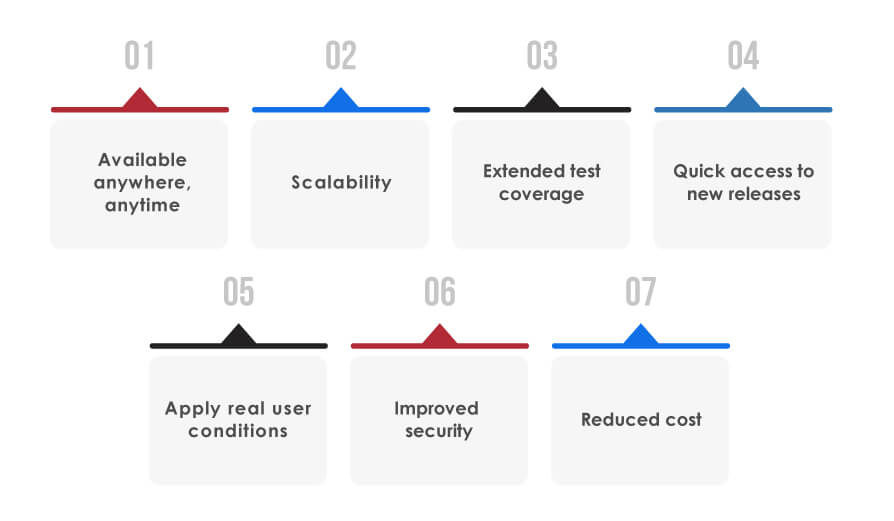
- What is Cloud-Based Test Automation?
- How Is It Helpful?
- Moving to the Cloud – A Strategic Move
- Advantages of Cloud-Based Test Automation
- How is it Beneficial for Cloud Testing?
- Moving to the Cloud – A Strategic Approach?
- Choosing a Cloud-Based Test Automation Software Provider
56% of the businesses are busy surviving daily operations rather than driving innovation. Whereas, embracing new technologies and methodologies is crucial to meet rising customer demands or effective digital transformation.
To address this, most of the businesses have invested in agile ways of working and DevOps, introducing a fresh approach to software development. However, one of the crucial elements of DevOps is test automation that enables development teams to automate the repetitive aspects of software testing, helping businesses to focus on more innovative and value-added tasks.
And, with the increasing number of organizations making a move to the cloud, a window to further improve and modernize the testing phase in your Software Development Lifecycle (SDLC) arises, i.e. – Cloud-Based Test Automation.
What is Cloud-Based Test Automation?

It is an approach that leverages cloud technology to accelerate testing and software releases. It creates test environments on-demand, helps software teams develop continuously, test, and release the digital products without any need to provision new infrastructure. This overall leads to having more test environment coming up with faster test execution.
How Is It Helpful?

Cloud-Based Test automation works to modernize your software development; however, it isn’t a one-size fits-all solution. When you test your software on-premises and release it quickly enough to keep up with the user demand, it works. On the other hand, if your existing infrastructure offers you enough test environments for your team to fix bugs and release new features simultaneously, it helps!
Cloud-Based Test Automation is for the teams to help them reduce their testing cycles and increase the release velocity. Since it has clear benefits, it can also throw up some challenges. No matter if you move entirely to the cloud, join it with your existing infrastructure, or choose to keep all the testing on-premises, it needs to be considered a part of your company’s software development strategy. No matter what strategy you eventually choose; you need to ensure that keeping the operations on and just surviving isn’t done at the cost of innovating and futureproofing your business.
Moving to the Cloud – A Strategic Move

When it comes to the SDLC process, developers view testing as the number one cause of delays in software development. Thus, practical steps towards removing the bottleneck should be a strategic priority for IT leaders. Cloud-based test automation can assist.
Delivering fast, secure, and reliable software through on-premises infrastructure is feasible if resources meet the demands of testing requirements. However, are you struggling to keep pace? Is your current testing infrastructure hindering your release schedule? Are you forced to choose between testing new features and fixing bugs in previous versions?
While some organizations and digital-first startups fully adopt a 100% cloud-based testing strategy, there are benefits to integrating cloud technology with existing on-premises infrastructure. The way cloud technology is implemented depends on company strategy, but many IT leaders are already leveraging its scalability and collaborative features to enable faster software releases.
Advantages of Cloud-Based Test Automation
The benefits of cloud-based test automation are mainly associated with utilizing multiple on-demand test environments to conduct automated tests. For instance, if a single local machine takes 10 hours to run tests, you could reduce this to 1 hour by accessing 10 machines simultaneously in the cloud.
Here are the key benefits of cloud-based test automation:

How is it Beneficial for Cloud Testing?
Easy Accessibility
When it comes to testing cloud, it can be accessed from anywhere, at any given time. This is the epitome for globally dispersed teams, which is a common place for digital enterprises. It is also incredibly inconvenient for teams working remotely. With Cloud in place, teams can work together in real-time with a testing cloud, without any delays due to the waiting time.
Easy to Scale
Cloud computing has been majorly supporting the ability to scale IT resources based on demand, with minimal disruption. This applies to cloud-based test automation. As test requirements change, organizations may experience a rise or a downfall in their testing capabilities by automating the scaling of test execution.
Wide Test Cases Covered
To ensure your application is performing across all platforms in all conditions, it’s analytical to include a mix of OS and devices to cover all of your app’s functionalities. Cloud testing not just gives access to the devices and browsers against which the tests need to be performed.
Real-Time Validation
When it comes to on-prem solutions, these can be limited for your testing strategy. Teams may face environmental restrictions, like Wi-Fi availability or so. They also get bogged down with the upkeep of testing infrastructure and hardware maintenance.
Moving to the Cloud – A Strategic Approach

Businesses are moving to the cloud which is a smart way to experience many advantages like agility, scalability, and overall competitiveness. One of the core principles of DevOps and Agile is the ability to rapidly iterate and deploy. Cloud platforms offer the necessary infrastructure to continuously support integration and continuous delivery (CI/CD) pipelines. Using this, deployment teams can automate the process, reducing the overall time between code commits and production releases. This agility is crucial for maintaining a competitive edge in the fast-paced market.
The cloud also enhanced collaboration and communication among cross-functional teams, which is important for agile and DevOps methodologies. The cloud-based services and tools offer real-time collaboration, allowing quality assurance teams to work in alliance, regardless of their physical locations. The unified environment thus helps to break down silos, offers a culture of shared responsibility ensuring that everyone is aligned with the same objectives and goals.
In addition to this, the cloud’s flexibility and scalability are a key for supporting the ever-changing nature of Agile and DevOps practices. Development teams usually need different levels of resources throughout the software development lifecycle. With cloud infrastructure, teams can easily scale their computing resources up or down which is demand based. This helps deliver the right capacity at the right time. Also, this elasticity allows efficient cost savings, and the ability to handle the peak loads during critical phases of deployment and testing without having to invest in a permanent infrastructure.
Choosing a Cloud-Based Test Automation Software Provider

• If your organization is planning to make a move or improvise on the existing cloud-based automation services, here are the key things to consider before taking the final decision.
• Seamless integration with your CI/CD pipeline to accelerate automation, small feedback loops, quick software delivery.
• Integration with existing on-premises testing infrastructure for easy test management and reporting.
• Real-time insights and monitoring capabilities to access remotely for better understanding of user journeys and the usage of application.
• Non-invasive testing for intelligent image recognition and OCR to ensure that test scripts sustain UI functionality and code alterations.
Discover more
Get in Touch
Stay Updated
Subscribe for more info




